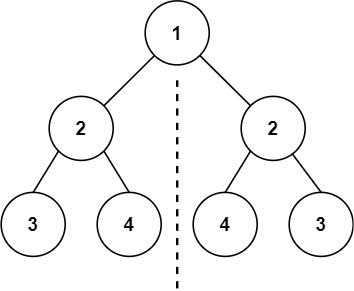Given the root of a binary tree, check whether it is a mirror of itself (i.e., symmetric around its center).
Example 1:

Input: root = [1,2,2,3,4,4,3] Output: true
Example 2:

Input: root = [1,2,2,null,3,null,3] Output: false
Constraints:
[1, 1000].-100 <= Node.val <= 100Follow up: Could you solve it both recursively and iteratively?
The core challenge of this problem is to determine if a binary tree is symmetric around its center. This means that the left subtree should be a mirror reflection of the right subtree.
Common applications of this problem include validating data structures that need to be symmetric, such as certain types of balanced trees.
Potential pitfalls include not correctly handling null nodes or assuming that the tree is always balanced.
To solve this problem, we can use two main approaches: recursive and iterative.
The recursive approach involves checking if the left subtree is a mirror reflection of the right subtree. This can be done by writing a helper function that compares two nodes and their respective subtrees.
The iterative approach uses a queue to perform a level-order traversal, comparing nodes at each level to ensure they are mirror images of each other.
/**
* Definition for a binary tree node.
* public class TreeNode {
* int val;
* TreeNode left;
* TreeNode right;
* TreeNode() {}
* TreeNode(int val) { this.val = val; }
* TreeNode(int val, TreeNode left, TreeNode right) {
* this.val = val;
* this.left = left;
* this.right = right;
* }
* }
*/
public class Solution {
public boolean isSymmetric(TreeNode root) {
if (root == null) return true;
return isMirror(root.left, root.right);
}
private boolean isMirror(TreeNode t1, TreeNode t2) {
if (t1 == null && t2 == null) return true;
if (t1 == null || t2 == null) return false;
return (t1.val == t2.val)
&& isMirror(t1.right, t2.left)
&& isMirror(t1.left, t2.right);
}
}
import java.util.LinkedList;
import java.util.Queue;
public class Solution {
public boolean isSymmetric(TreeNode root) {
if (root == null) return true;
Queue<TreeNode> queue = new LinkedList<>();
queue.add(root.left);
queue.add(root.right);
while (!queue.isEmpty()) {
TreeNode t1 = queue.poll();
TreeNode t2 = queue.poll();
if (t1 == null && t2 == null) continue;
if (t1 == null || t2 == null) return false;
if (t1.val != t2.val) return false;
queue.add(t1.left);
queue.add(t2.right);
queue.add(t1.right);
queue.add(t2.left);
}
return true;
}
}
Both the recursive and iterative solutions have a time complexity of O(n), where n is the number of nodes in the tree. This is because each node is visited once.
The space complexity for the recursive solution is O(h), where h is the height of the tree, due to the call stack. For the iterative solution, the space complexity is O(n) due to the queue.
Potential edge cases include:
To test the solution comprehensively, consider the following test cases:
When approaching such problems, it is helpful to:
Understanding and solving the symmetric tree problem is crucial for mastering tree-based algorithms. It helps in developing a deeper understanding of tree traversal techniques and recursive problem-solving.
Practice is key to mastering these concepts. Try solving similar problems and explore different tree traversal algorithms to improve your skills.
For further reading and practice, consider the following resources:
Our interactive tutorials and AI-assisted learning will help you master problem-solving skills and teach you the algorithms to know for coding interviews.
Start Coding for FREE